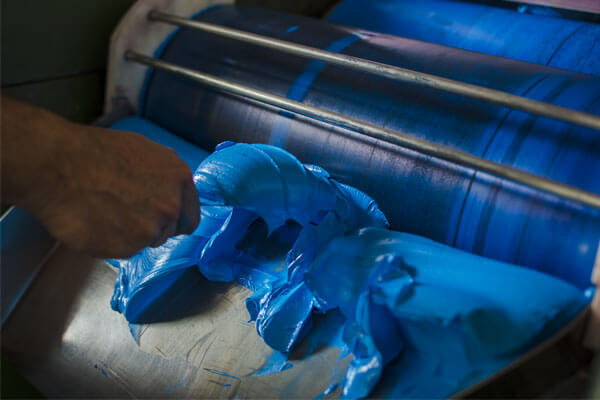
From one of the world’s most respected paint-makers, David Coles, Chromatopia reveals the stories behind fifty striking pigments. In this extract, Coles discusses the extraordinary process through which paint is made.
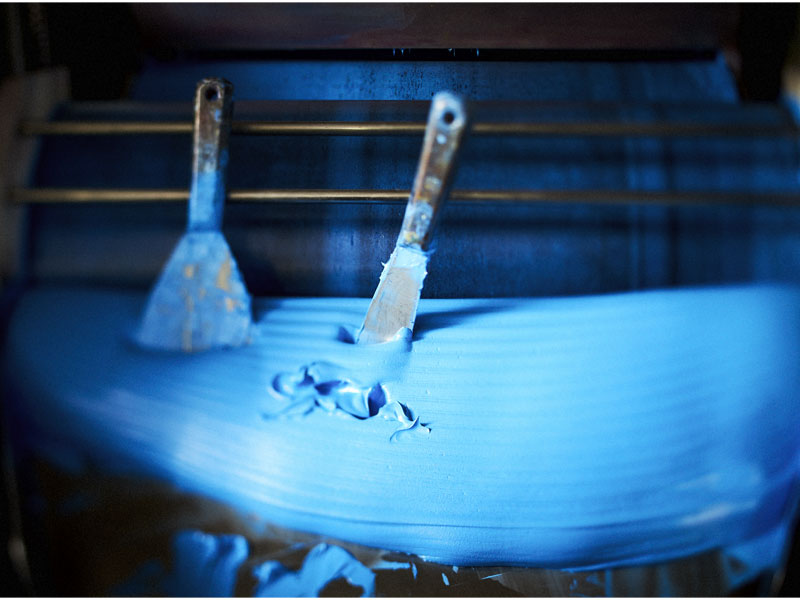
This book has looked at the origins of historical and contemporary pigments, but pigments are hardly ever used in their raw form. To be usefully employed as a colour, billions of individual grains of pigment must be glued together with a binder. This is, in essence, how you make paint.
Throughout history, people have found ways to permanently ‘fix’ colour to create lasting images of the most exquisite beauty. For instance, the binding of pigments in Neolithic cave paintings was probably serendipitous; cave walls containing silicas or limestone trapped the pigment and locked it to the surface over time. Since then, we have discovered a host of sticky, adhesive materials in nature that could hold pigments in place. Some of these earliest binders are still used by artists. Gum arabic, the water-soluble sap of the North African acacia tree, makes watercolours; and beeswax, collected and refined from hives, makes encaustic (molten wax) paint.
Mixing pigments with different binders successfully converts them into a material for uses as diverse as house paints, plastics, writing inks, automotive coatings, paper and – of most interest to me – artists’ paint.
In my role as a master paint-maker, I make oil paint, which are by dispersing pigments in a ‘drying oil’ such as linseed, walnut, poppy or safflower oils. Linseed oil is by far the most important and widely used drying oil. When drying oils absorb oxygen they convert from a liquid into a hard, permanent coating. Pigments can be bound with very small amounts of oil. This means that oil paints contain much higher amounts of the pigment than watercolour or acrylic paints. For artists, this gives the paint a physical feeling. The paintbrush is literally pushing around dense, coloured pastes.
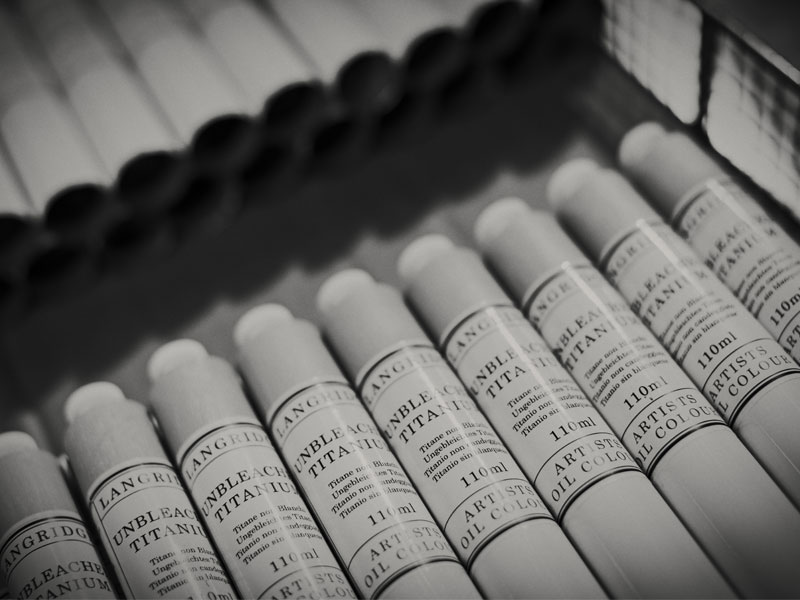
So how do we make our paint? Our first task was to source a high-quality linseed oil. We selected ours after sampling dozens of products from suppliers all over the world. We were looking for a clean, straw-coloured oil that was free of natural impurities. It had to have a good drying rate and minimal yellowing as it aged. Eventually we chose exceptional bright, clear oils made in Holland and Germany.
Next comes the selection of the pigments. There are so many manufacturers of pigments that the choice seems overwhelming. We hunt out pigments that have qualities equal to their noble intended use: they must be as lightfast as possible, chemically stable and exhibit colour qualities of benefit to the artist. The vast majority of pigments do not meet our needs. They are built for larger, more commercially important industries and have been tailored for industrial applications.
To select our pigments, we go through a long period of investigation. We select colours of interest, research the chemical construction of the pigment, and assess its suitability for artists’ paint before requesting samples for laboratory trials. The anticipation of opening a sample box and seeing a new pigment for the first time, in its raw unadulterated form, is exhilarating. There is always the nervous hope that the promise held out by this new pigment will be borne out, that its potency will not dull, and that its colour will not be lost when it is mixed with the binder. Backwards and forwards go the experiments – working out the right amount of pigment to add to the oil and correcting for undesirable qualities. Like a chef honing a new dish, small, delicate changes in the recipe can lead to dramatic differences in the finished product.
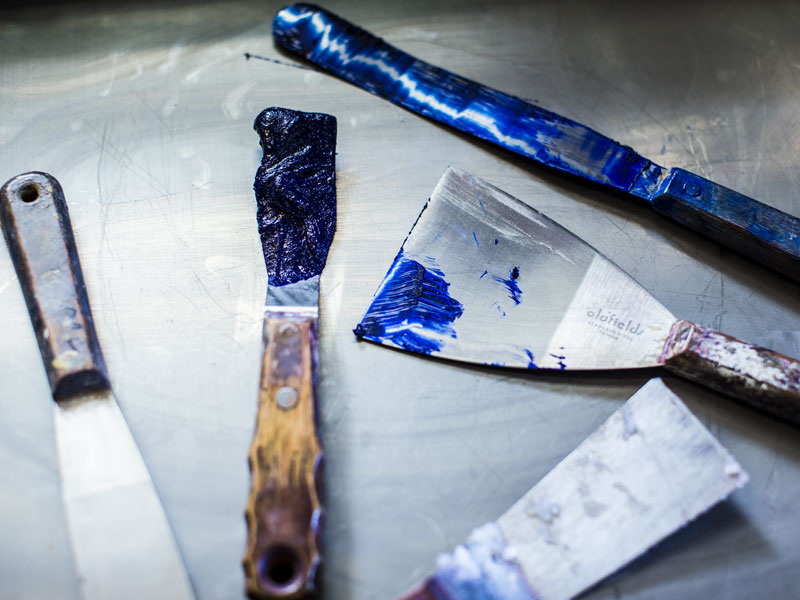
When we are ready to make the paint, the linseed oil is weighed out into 60-litre heavy-duty stainless-steel bowls. All of our manufacturing equipment and surfaces are stainless steel. The equipment is kept meticulously clean to prevent any chance of other colours contaminating the purity of each new batch.
Stearate, a wax-like material that is essential to the wetting and stability of the paint, is weighed and added to the oil. The bowl is secured in a planetary mixer and large, powerful motors slowly rotate the blade through the wax and oil mixture.
Next, another steel bowl is placed on the electronic scales, ready for the pigment. Even after all these years, opening the bins of pure pigment is a ridiculously breathtaking assault on the eyes. The pigment is scooped out, weighed and added slowly to the oil. There are no short cuts. Adding all the pigment at once would make incorporation impossible. The liquid oil allows the individual grains of colour to slide over each other. The physical shape of pigments means that, without this lubrication, they would drag over each other, causing extraordinary resistance, reducing the mixing action and – as happened once very early on – breaking the very expensive blade of the mixer.
The slow churning of the paste begins. Over the rumbling of the mixer’s motor, you can hear delicious slurping noises as the blade methodically drives through the mixture. As the dry pigment is gradually incorporated with the wet oil, it changes from an incredibly thick batter into what looks like an enormous vat of vividly coloured butter.
This process can take as long as four hours, but it is not the finished paint. Under close inspection, vast quantities of the pigments still cling together rather than being individually coated. This is where the triple-roll mill comes in.
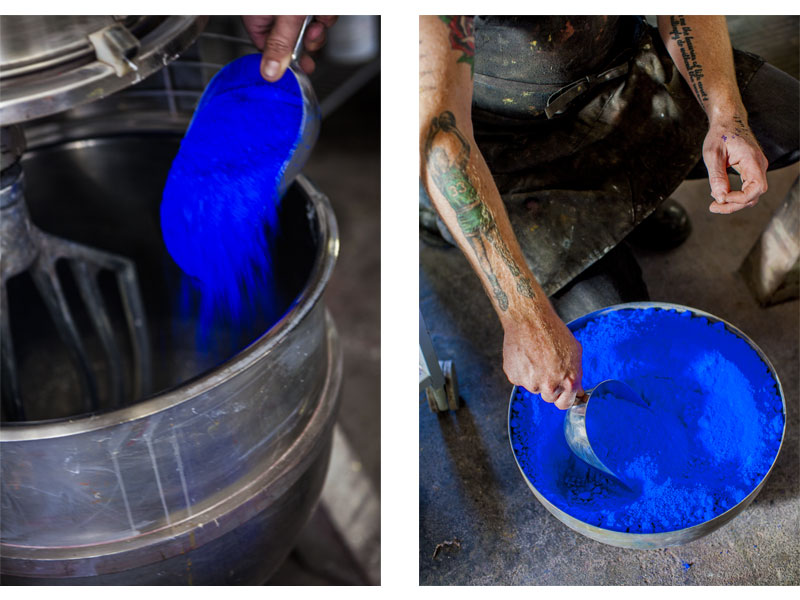
A triple-roll mill is at the heart of paint-making. At its most basic, it is three horizontal granite rollers that each run at different speeds and spin in alternating directions. The paste is scraped out of the mixer’s bowl with a baker’s blade and dropped into the hopper. Each giant dollop makes a delicious slap as it plops onto the rollers below. The paste is drawn down into the tiny space between the rollers, again and again. With each pass, the space is narrowed to more aggressively separate the pigment particles. If you have ever used a pasta-making machine with its two rollers forcing the dough through the small space between them you can understand the paint-making process. Just as the roughly made dough cannot pass through the narrowest setting first, so the pigment-paste must be passed through the mill rollers multiple times. It’s just that our mill is like a pasta-machine on steroids, with three rollers rather than two and a massive motor to drive the material through. For soft pigments such as zinc white only three passes are needed, but the synthetics can take up to nine passes. Synthetic pigments are very difficult to prize apart: their incredibly small size and specific shape mean they have to be painstakingly teased into dispersion.
The paint-maker must be constantly attentive to the vagaries of milling. Rollers heat up under the friction of pigment particles, which alters the size of the roller gap, and the fluidity of the oil is affected by changes in ambient temperature. Also, pigments behave differently from one batch to another. This is especially true of the natural earths, which vary in their mineral make-up depending on the part of the seam the earth was dug from.
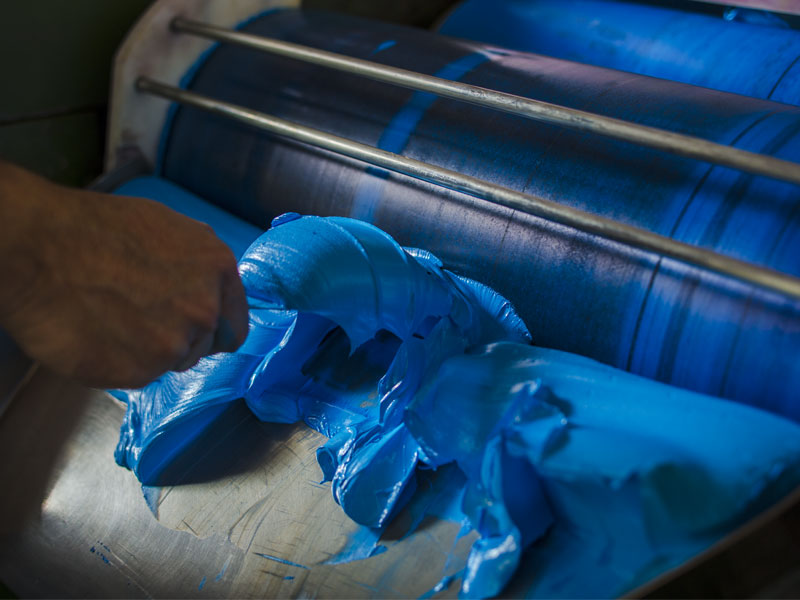
Towards the end of the paint-making process, we take samples of the paint and test it for quality. Historically, paint-makers would rub the paint between their thumbnails – a simple but surprisingly delicate solution to feel for the grittiness of unmixed pigment. Nowadays we use a precisely honed stainless-steel gauge to check the quality of dispersion.
But we are still not ready to sign off on the product. Two extremely thin films of the freshly made paint are applied to paint-maker’s cards. One daub is the pure paint. The other is the paint mixed with a specified amount of titanium white. By placing the card next to one from a previous batch of the same colour, we can ensure that every time we make the paint it has identical colour, tinting strength, tint colour and undertone to all previous versions.
Only after the paint has passed these tests is it approved for packing. It is hand-filled into collapsible aluminium paint tubes, labelled with hand-painted swatches of the individual colour, boxed and shipped to studios around the world.
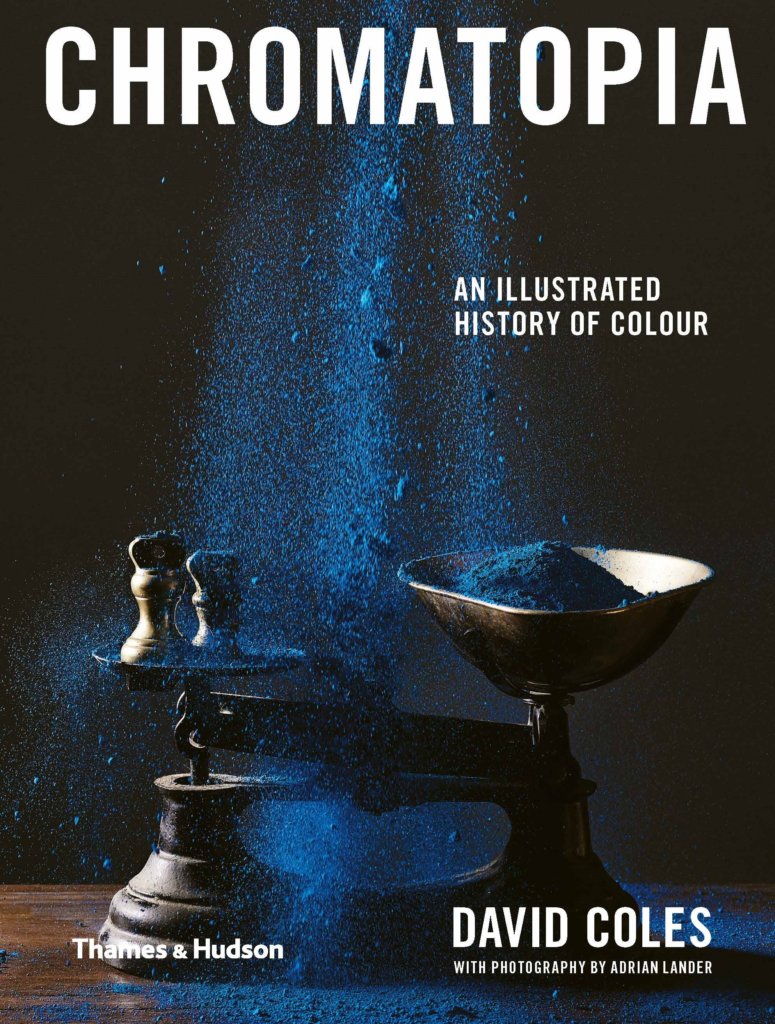
Chromatopia is available now. Text by David Coles, photography by Adrian Lander, and cover design by Evi. O Studio.
AU$34.99
Posted on June 17, 2020